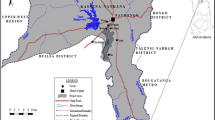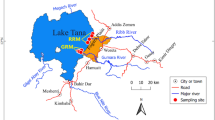Abstract
This 3 × 3 factorial study assessed pyrethroids, carbamates and neonicotenoids groups of pesticides in replicated samples of three fish species from low (S1, reference), medium (S2) and heavy (S3) polluted sites receiving agricultural run-offs around the Indus River. Water and sediment samples from the same sites were also analysed for these pesticides by using high-performance liquid chromatography. Out of nine investigated pesticides, only three pesticides (deltamethrin, carbofuran and cypermethrin) were detected in fish and sediment samples. Deltamethrin in Cyprinus carpio ranged from 0.490 to 0.839 μg/g, mostly exceeding 0.5 μg/g as the maximum residual limit suggested by FAO-WHO, whereas it ranged from 0.214 to 0.318 μg/g in the sampled sediments. The carbofuran concentrations were 0.0425–0.066 and 0.613–0.946 μg/g in Labeo rohita and Channa marulius muscles respectively and 0.069–0.081 μg/g in the corresponding sediment samples. These values were either higher or lower than the maximum limit (0.1 μg/g) as suggested by FAO-WHO. Conversely, the cypermethrin concentration ranged from 0.141 to 0.174 in Ch. marulius and 0.183–0.197 μg/g in sediments which were both below the FAO-WHO maximum limit of 2 μg/g. No pesticide residues were detected in water from these sampling sites. Most selected physicochemical variables were within the acceptable range of World Health Organization for the water quality for aquatic life. The detected pesticide contents were mostly higher in fish muscles from heavily polluted sites. This is worrying because these pesticides may pose health risks for the fish and people of the study area. However, a preliminary risk assessment indicated that the calculated daily intake of detected pesticides by people consuming fish from the Indus River was low and did not present an immediate risk to the fish-consuming people. This study may be used as a benchmark to determine the safety of fish meat in order to develop intervention strategies to maintain the water quality and to protect the health of fish and fish-consuming people.
Similar content being viewed by others
References
Abowei, J. F. N. (2012). Salinity, dissolved oxygen, pH and surface water temperature conditions in Nkoro river, Niger Delta, Nigeria. Advance Journal of Food Science and Toxicology, 2, 36–40.
Akhtar, M., Mahboob, S., Sultana, S., & Sultana, T. (2012). Assessment of pesticide residues in sediments collected from river Ravi and its tributaries between its stretches from Shahdara to Balloki headworks, Pakistan. Journal of Biology, Agriculture and Healthcare, 2, 127–133.
Amweg, E. L., Weston, D. P., You, J., & Lydy, M. J. (2006). Pyrethroid insecticide and sediment toxicity in urban creeks from California and Tennessee. Environmental Science and Technology, 40, 1700–1706.
Anampiu, J. M. M. (2011). Organochlorine pesticides residues in fish and sediment from Lake Naivasha. MSc thesis, University of Nairobi.
Aydin, R., Koprucu, K., Dorucu, M., Koprucu, S. S., & Pala, M. (2005). Acute toxicity of synthetic pyrethroid cypermethrin on the common carp (Cyprinus carpio L.) embryos larvae. Aquaculture International, 13, 451–458.
Begum, G. (2005). In vivo biochemical changes in liver and gill of Clarias batrachus during cypermethrin exposure and following cessation of exposure. Pesticide Biochemistry and Physiology, 82, 185–196.
Chaudhry, A. S., & Jabeen, F. (2011). Assessing metal, protein and DNA profiles in Labeo rohita from the Indus river in Mianwali, Pakistan. Environmental Monitoring and Assessment, 174, 665–679.
Chowdhury, A. Z., Jahan, S. A., Islam, M. N., Moniruzzaman, M., Alam, K. M., Zaman, M. A., et al. (2012). Occurance of organophosphorus and carbamate pesticides residues in surface water sample from the Rangpur District of Bangladesh. Earth and Environmental Science, 89, 202–207.
Ensibi, C., Moreno, D. H., Santiyan, M. P. M., Yahya, M. N. D., Rodriguez, F. S., & Lopez, M. P. (2012). Effects of carbofuran and deltamethrin on acetylcholinesterase activity in brain and muscles of common carp. Environmental Toxicology. doi:10.1002/tox.21765.
EPA (United States Environmental Protection Agency) (2006). Current National Recommended Water quality criteria. http://www.epa.gov/waterscience/criteria/wqcriteria.html.
Estevez, M. A., Perigo, E. L., Carballo, E. M., Gandara, J. S., Mejuto, J. C., & Rio, L. G. (2008). The mobility and degradation of pesticides in soil and the pollution of groundwater resources. Agriculture, Ecosystems & Environment, 123, 247–260.
Ezemonye, L. I. N. (2005). Polychlorinated Biphenyls (PCBs) levels and distributions in Ethiope and Benin rivers of the Niger Delta, Nigeria: surface water and sediment. International Journal of Environmental Studies, 62, 491–504.
FAO-WHO (2013). Codex, maximum residue limits for pesticides. FAO. www.codexalimentarius.net/pestres/data/pesticides/index.htmL. Assessed 01 Sept 2014.
Feo, M. L., Ginebreda, A., Eljarrat, E., & Barcelo, D. (2010). Presence of pyrethroid pesticides in water and sediments of Ebro river Delta. Journal of Hydrology, 393, 156–162.
Gautam, P. P., & Gupta, A. K. (2008). Toxicity of cypermethrin to the juveniles of freshwater fish Poecilia reticulate (peters) in relation to selected environmental variables. Natural Product Radiance, 7, 314–319.
Gul, A., Yilmaz, M., Kuscu, A., & Benzer, S. (2010). Feeding properties of common carp living in Hirfanli Dam Lake. Kastamonu Education Journal, 18, 545–556.
Jabeen, F., & Chaudhry, A. S. (2010a). Environmental impacts of anthropogenic activities on the mineral uptake in Oreochromis mossambicus from the Indus river in Pakistan. Environmental Monitoring and Assessment, 166, 641–651.
Jabeen, F., & Chaudhry, A. S. (2010b). Monitoring trace metals in different tissues of Cyprinus carpio from the Indus river in Pakistan. Environmental Monitoring and Assessment, 170, 645–656.
Kafilzadeh, F., Shiva, A. H., Malekpour, R., & Azad, H. N. (2012). Determination of organochlorine pesticide residues in water, sediments and fish from Lake Parishan, Iran. World Journal of Fish and Marine Sciences, 4, 150–154.
Khan, M. A., Khan, S., & Mian, K. (2012). Length-weight relationship of giant snakehead, Channa marulius and stinging catfish, Heteropaneustes fossilis from river Ganga, India. Journal of Applied Ichthyology, 28, 154–155.
Lao, W., Tsukada, D., Greenstein, D. J., Bay, S. M., & Maruya, K. A. (2010). Analysis, occurrence and toxic potential of pyrethroids and fipronil in sediments from an urban Estuary. Environmental Toxicology and Chemistry, 29, 843–851.
Miranda, R. B. G., Raetano, G. C., Silva, E., Daem, A. M., & Cerejeira, M. J. (2011). Environmental fate of neonicotenoids and classification of their potential risks to hypogean, epygean, and surface water ecosystem in Brazil. Human and Ecological Risk Assessment, 17, 981–995.
Mohamed, A. S. F. (2009). Histopathological studies on Tillapia zilli and Solea vulgaris from Lake Qarun, Egypt. World Journal of Fish and Marine Sciences, 1, 29–39.
Rasool, F., Qureshi, N. A., Parveen, S., Siddique, M., Hameed, A., Ashraf, M., et al. (2013). Principal component analysis for the variation among the population of Labeo rohita. Journal of Animal and Plant Sciences, 23, 487–492.
Riaz, A. M. (2008). Studies on the feasibility of raising Channa marulius with Tilapia by using different predator-prey stocking ratios in fertilized ponds. PhD thesis, University of Agricultural Faisalabad.
Richterova, Z., & Svobodova, Z. (2012). Pyrethroid influence on fish. Slovenian Veterinary Research, 49, 63–72.
Saha, S., & Kaviraj, A. (2009). Effects of cypermethrin on some biochemical parameters and its amelioration through dietary supplementation of ascorbic acid in freshwater catfish Heteropneustes fossilis. Chemosphere, 74, 1254–1259.
Singh, M. R., Gupta, A., & Beeteswari, K. (2010). Physicochemical properties of water sampled from Manipur river System, India. Journal of Applied Sciences and Environmental Management, 14, 85–89.
Upadhi, F., & Wokoma, O. A. F. (2012). Examination of some pesticide residues in surface water, sediment and fish tissue of Elechi Creek, Niger Delta, Nigeria. Research Journal of Environmental and Earth Sciences, 4(11), 939–944.
Vryzas, Z., Alexoudis, C., Vassiliou, G., Galanis, K., & Mourkidou, E. P. (2011). Determination and aquatic risk assessment of pesticide residues in riparian drainage canals in Northeastern Greece. Ecotoxicology and Environmental Safety, 74, 174–181.
WHO (World Health Organization). (1990). Environmental health criteria 97—deltamethrin (1990th ed.). Geneva: International Programme on Chemical Safety (IPCS), World Health Organization.
WHO (World Health Organization) (1997). Guidelines for predicting dietary intake of pesticide residues (revised). Prepared by the Global Environment Monitoring System–Food Contamination Monitoring and Assessment Programme (GEMS/Food) in collaboration with the Codex Committee on Pesticide Residues. Geneva: Programme of Food Safety and Food Aid.
WHO (World Health Organization) (2004). Chemical Fact Sheets of the International Programme on Chemical Safety (ICPS) of the World Health Organization (WHO), Geneva. www.who.int/entity/water_sanitation_health /dwq/en/gdwq3_12.pdf. Accessed 9 Mar 2014.
WHO (World Health Organization) (2006). Wastewater reuse in agriculture, volume 2. World Health Organization.
Yang, Y., Huihui, M., Zhou, J., Liu, J., & Liu, W. (2014). Joint toxicity of permethrin and cypermethrin at sublethal concentrations to the embryo-larval zebrafish. Chemosphere, 96, 146–154.
Yilmaz, M., Gul, A., & Erbasli, K. (2004). Acute toxicity of alpha-cypermethrin to guppy (Poecilia reticulata, Pallas, 1859). Chemosphere, 56, 38–385.
Acknowledgments
The authors gratefully acknowledge the Higher Education Commission of Pakistan and British Council for funding the INSPIRE project SP-174 (2011-2014). Muhammad Abdullah Khan Niazi and Kaleemullah of GHS PAF Mianwali Pakistan, Naveed, Shahnam, Shaheer, Ibtisam, Aliya and Aima are acknowledged for their help and cooperation during the fish sampling from the Indus River around Mianwali, Pakistan.
Author information
Authors and Affiliations
Corresponding authors
Rights and permissions
About this article
Cite this article
Jabeen, F., Chaudhry, A.S., Manzoor, S. et al. Examining pyrethroids, carbamates and neonicotenoids in fish, water and sediments from the Indus River for potential health risks. Environ Monit Assess 187, 29 (2015). https://doi.org/10.1007/s10661-015-4273-4
Received:
Accepted:
Published:
DOI: https://doi.org/10.1007/s10661-015-4273-4




